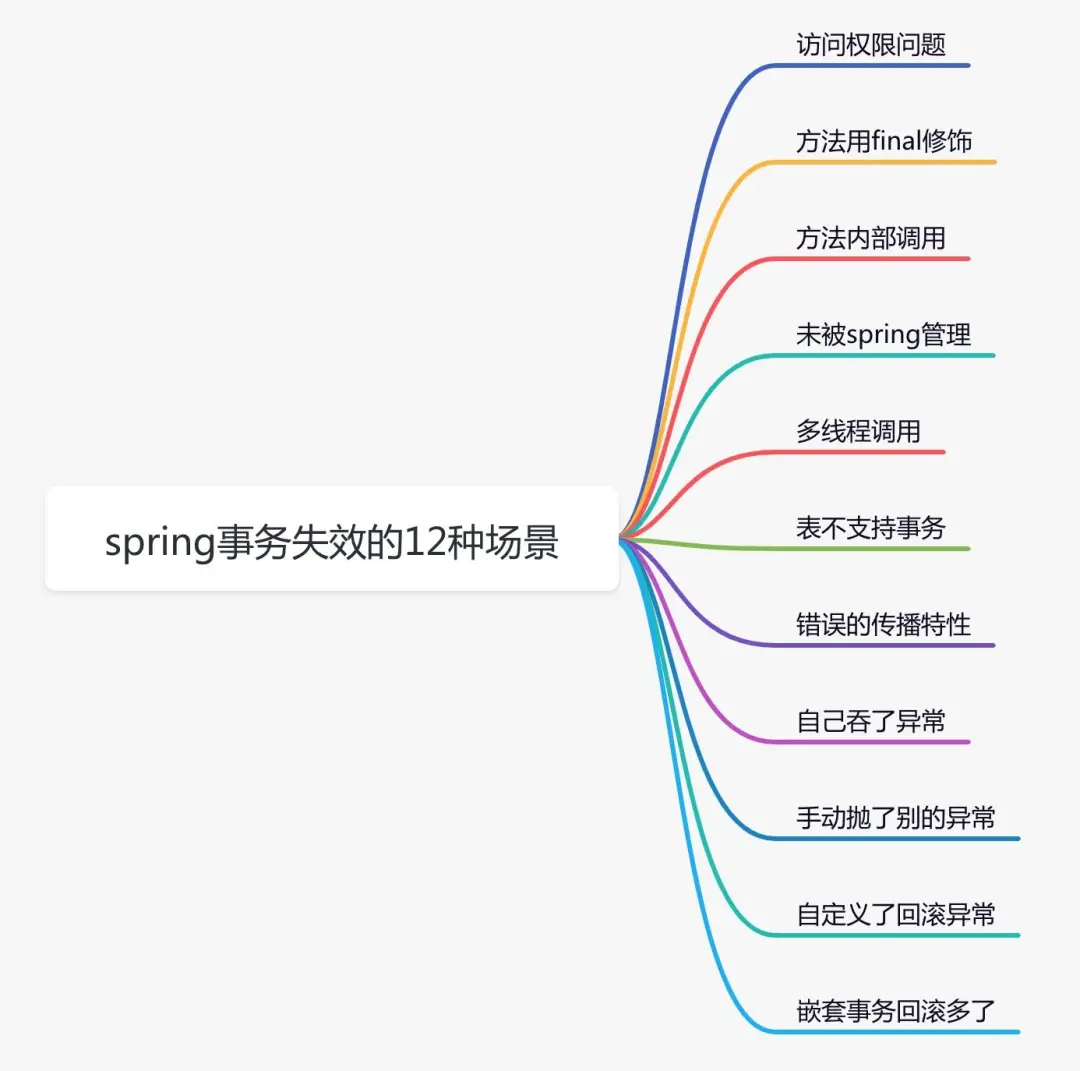一、事务不生效
1.访问权限问题
众所周知,java的访问权限主要有四种:private、default、protected、public,它们的权限从左到右,依次变大。
但如果在开发过程中,把有某些事务方法,定义了错误的访问权限,就会导致事务功能出问题,例如:
@Servicepublic class UserService {@Transactionalprivate void add(UserModel userModel) {saveData(userModel);updateData(userModel);}}
可以看到add方法的访问权限被定义成了private,这样会导致事务失效,spring要求被代理方法必须是public的。
说白了,在AbstractFallbackTransactionAttributeSource类的computeTransactionAttribute方法中有个判断,如果目标方法不是public,则TransactionAttribute返回null,即不支持事务。
protected TransactionAttribute computeTransactionAttribute(Method method, @Nullable Class<?> targetClass) {// Don't allow no-public methods as required.if (allowPublicMethodsOnly() && !Modifier.isPublic(method.getModifiers())) {return null;}// The method may be on an interface, but we need attributes from the target class.// If the target class is null, the method will be unchanged.Method specificMethod = AopUtils.getMostSpecificMethod(method, targetClass);// First try is the method in the target class.TransactionAttribute txAttr = findTransactionAttribute(specificMethod);if (txAttr != null) {return txAttr;}// Second try is the transaction attribute on the target class.txAttr = findTransactionAttribute(specificMethod.getDeclaringClass());if (txAttr != null && ClassUtils.isUserLevelMethod(method)) {return txAttr;}if (specificMethod != method) {// Fallback is to look at the original method.txAttr = findTransactionAttribute(method);if (txAttr != null) {return txAttr;}// Last fallback is the class of the original method.txAttr = findTransactionAttribute(method.getDeclaringClass());if (txAttr != null && ClassUtils.isUserLevelMethod(method)) {return txAttr;}}return null;}
也就是说,如果自定义的事务方法(即目标方法),它的访问权限不是public,而是private、default或protected的话,spring则不会提供事务功能。
2. 方法用final修饰
有时候,某个方法不想被子类重新,这时可以将该方法定义成final的。普通方法这样定义是没问题的,但如果将事务方法定义成final,例如:
@Servicepublic class UserService {@Transactionalpublic final void add(UserModel userModel){saveData(userModel);updateData(userModel);}}
可以看到add方法被定义成了final的,这样会导致事务失效。
为什么?
如果看过spring事务的源码,可能会知道spring事务底层使用了aop,也就是通过jdk动态代理或者cglib,生成了代理类,在代理类中实现的事务功能。
但如果某个方法用final修饰了,那么在它的代理类中,就无法重写该方法,而添加事务功能。
注意:如果某个方法是static的,同样无法通过动态代理,变成事务方法。
3.方法内部调用
有时候需要在某个Service类的某个方法中,调用另外一个事务方法,比如:
@Servicepublic class UserService {@Autowiredprivate UserMapper userMapper;@Transactionalpublic void add(UserModel userModel) {userMapper.insertUser(userModel);updateStatus(userModel);}@Transactionalpublic void updateStatus(UserModel userModel) {doSameThing();}}
看到在事务方法add中,直接调用事务方法updateStatus。从前面介绍的内容可以知道,updateStatus方法拥有事务的能力是因为spring aop生成代理了对象,但是这种方法直接调用了this对象的方法,所以updateStatus方法不会生成事务。
由此可见,在同一个类中的方法直接内部调用,会导致事务失效。
那么问题来了,如果有些场景,确实想在同一个类的某个方法中,调用它自己的另外一个方法,该怎么办呢?
3.1 新加一个Service方法
这个方法非常简单,只需要新加一个Service方法,把@Transactional注解加到新Service方法上,把需要事务执行的代码移到新方法中。具体代码如下:
@Servciepublic class ServiceA {@Autowiredprvate ServiceB serviceB;public void save(User user) {queryData1();queryData2();serviceB.doSave(user);}}@Servciepublic class ServiceB {@Transactional(rollbackFor=Exception.class)public void doSave(User user) {addData1();updateData2();}}
3.2 在该Service类中注入自己
如果不想再新加一个Service类,在该Service类中注入自己也是一种选择。具体代码如下:
@Servciepublic class ServiceA {@Autowiredprvate ServiceA serviceA;public void save(User user) {queryData1();queryData2();serviceA.doSave(user);}@Transactional(rollbackFor=Exception.class)public void doSave(User user) {addData1();updateData2();}}
3.3 通过AopContent类
在该Service类中使用AopContext.currentProxy()获取代理对象
上面的方法2确实可以解决问题,但是代码看起来并不直观,还可以通过在该Service类中使用AOPProxy获取代理对象,实现相同的功能。具体代码如下:
@Servciepublic class ServiceA {public void save(User user) {queryData1();queryData2();((ServiceA)AopContext.currentProxy()).doSave(user);}@Transactional(rollbackFor=Exception.class)public void doSave(User user) {addData1();updateData2();}}
4.未被spring管理
在平时开发过程中,有个细节很容易被忽略。即使用spring事务的前提是:对象要被spring管理,需要创建bean实例。
通常情况下,通过@Controller、@Service、@Component、@Repository等注解,可以自动实现bean实例化和依赖注入的功能。
如果有一天,开发了一个Service类,但忘了加@Service注解,比如:
//@Servicepublic class UserService {@Transactionalpublic void add(UserModel userModel) {saveData(userModel);updateData(userModel);}}
从上面的例子,可以看到UserService类没有加@Service注解,那么该类不会交给spring管理,所以它的add方法也不会生成事务。
5.多线程调用
在实际项目开发中,多线程的使用场景还是挺多的。如果spring事务用在多线程场景中,会有问题吗?
@Slf4j@Servicepublic class UserService {@Autowiredprivate UserMapper userMapper;@Autowiredprivate RoleService roleService;@Transactionalpublic void add(UserModel userModel) throws Exception {userMapper.insertUser(userModel);new Thread(() -> {roleService.doOtherThing();}).start();}}@Servicepublic class RoleService {@Transactionalpublic void doOtherThing() {System.out.println("保存role表数据");}}
从上面的例子中,可以看到事务方法add中,调用了事务方法doOtherThing,但是事务方法doOtherThing是在另外一个线程中调用的。
这样会导致两个方法不在同一个线程中,获取到的数据库连接不一样,从而是两个不同的事务。如果想doOtherThing方法中抛了异常,add方法也回滚是不可能的。
如果看过spring事务源码的朋友,可能会知道spring的事务是通过数据库连接来实现的。当前线程中保存了一个map,key是数据源,value是数据库连接。
private static final ThreadLocal<Map<Object, Object>> resources = new NamedThreadLocal<>("Transactional resources");
说的同一个事务,其实是指同一个数据库连接,只有拥有同一个数据库连接才能同时提交和回滚。如果在不同的线程,拿到的数据库连接肯定是不一样的,所以是不同的事务。
6.表不支持事务
周所周知,在mysql5之前,默认的数据库引擎是myisam。
它的好处就不用多说了:索引文件和数据文件是分开存储的,对于查多写少的单表操作,性能比innodb更好。
有些老项目中,可能还在用它。
在创建表的时候,只需要把ENGINE参数设置成MyISAM即可:
CREATE TABLE `category` (`id` bigint NOT NULL AUTO_INCREMENT,`one_category` varchar(20) COLLATE utf8mb4_bin DEFAULT NULL,`two_category` varchar(20) COLLATE utf8mb4_bin DEFAULT NULL,`three_category` varchar(20) COLLATE utf8mb4_bin DEFAULT NULL,`four_category` varchar(20) COLLATE utf8mb4_bin DEFAULT NULL,PRIMARY KEY (`id`)) ENGINE=MyISAM AUTO_INCREMENT=4 DEFAULT CHARSET=utf8mb4 COLLATE=utf8mb4_bin
myisam好用,但有个很致命的问题是:不支持事务。
如果只是单表操作还好,不会出现太大的问题。但如果需要跨多张表操作,由于其不支持事务,数据极有可能会出现不完整的情况。
此外,myisam还不支持行锁和外键。
所以在实际业务场景中,myisam使用的并不多。在mysql5以后,myisam已经逐渐退出了历史的舞台,取而代之的是innodb。
有时候在开发的过程中,发现某张表的事务一直都没有生效,那不一定是spring事务的锅,最好确认一下使用的那张表,是否支持事务。
7.未开启事务
有时候,事务没有生效的根本原因是没有开启事务。
开启事务不是一个项目中,最基本的功能吗?
为什么还会没有开启事务?
没错,如果项目已经搭建好了,事务功能肯定是有的。
但如果是在搭建项目demo的时候,只有一张表,而这张表的事务没有生效。那么会是什么原因造成的呢?
当然原因有很多,但没有开启事务,这个原因极其容易被忽略。
如果使用的是springboot项目,那么很幸运。因为springboot通过DataSourceTransactionManagerAutoConfiguration类,已经默认开启了事务。
要做的事情很简单,只需要配置spring.datasource相关参数即可。
但如果使用的还是传统的spring项目,则需要在applicationContext.xml文件中,手动配置事务相关参数。如果忘了配置,事务肯定是不会生效的。
具体配置如下信息:
<!-- 配置事务管理器 --><bean class="org.springframework.jdbc.datasource.DataSourceTransactionManager" id="transactionManager"><property name="dataSource" ref="dataSource"></property></bean><tx:advice id="advice" transaction-manager="transactionManager"><tx:attributes><tx:method name="*" propagation="REQUIRED"/></tx:attributes></tx:advice><!-- 用切点把事务切进去 --><aop:config><aop:pointcut expression="execution(* com.susan.*.*(..))" id="pointcut"/><aop:advisor advice-ref="advice" pointcut-ref="pointcut"/></aop:config>
默默的说一句,如果在pointcut标签中的切入点匹配规则,配错了的话,有些类的事务也不会生效。
二、事务不回滚
1.错误的传播特性
其实,在使用@Transactional注解时,是可以指定propagation参数的。
该参数的作用是指定事务的传播特性,spring目前支持7种传播特性:
REQUIRED如果当前上下文中存在事务,那么加入该事务,如果不存在事务,创建一个事务,这是默认的传播属性值。SUPPORTS如果当前上下文存在事务,则支持事务加入事务,如果不存在事务,则使用非事务的方式执行。MANDATORY如果当前上下文中存在事务,否则抛出异常。REQUIRES_NEW每次都会新建一个事务,并且同时将上下文中的事务挂起,执行当前新建事务完成以后,上下文事务恢复再执行。NOT_SUPPORTED如果当前上下文中存在事务,则挂起当前事务,然后新的方法在没有事务的环境中执行。NEVER如果当前上下文中存在事务,则抛出异常,否则在无事务环境上执行代码。NESTED如果当前上下文中存在事务,则嵌套事务执行,如果不存在事务,则新建事务。
如果在手动设置propagation参数的时候,把传播特性设置错了,比如:
@Servicepublic class UserService {@Transactional(propagation = Propagation.NEVER)public void add(UserModel userModel) {saveData(userModel);updateData(userModel);}}
可以看到add方法的事务传播特性定义成了Propagation.NEVER,这种类型的传播特性不支持事务,如果有事务则会抛异常。
目前只有这三种传播特性才会创建新事务:REQUIRED,REQUIRES_NEW,NESTED。
2.自己吞了异常
事务不会回滚,最常见的问题是:开发者在代码中手动try…catch了异常。比如:
@Slf4j@Servicepublic class UserService {@Transactionalpublic void add(UserModel userModel) {try {saveData(userModel);updateData(userModel);} catch (Exception e) {log.error(e.getMessage(), e);}}}
这种情况下spring事务当然不会回滚,因为开发者自己捕获了异常,又没有手动抛出,换句话说就是把异常吞掉了。
如果想要spring事务能够正常回滚,必须抛出它能够处理的异常。如果没有抛异常,则spring认为程序是正常的。
3.手动抛了别的异常
即使开发者没有手动捕获异常,但如果抛的异常不正确,spring事务也不会回滚。
@Slf4j@Servicepublic class UserService {@Transactionalpublic void add(UserModel userModel) throws Exception {try {saveData(userModel);updateData(userModel);} catch (Exception e) {log.error(e.getMessage(), e);throw new Exception(e);}}}
上面的这种情况,开发人员自己捕获了异常,又手动抛出了异常:Exception,事务同样不会回滚。
因为spring事务,默认情况下只会回滚RuntimeException(运行时异常)和Error(错误),对于普通的Exception(非运行时异常),它不会回滚。
4.自定义了回滚异常
在使用@Transactional注解声明事务时,有时想自定义回滚的异常,spring也是支持的。可以通过设置rollbackFor参数,来完成这个功能。
但如果这个参数的值设置错了,就会引出一些莫名其妙的问题,例如:
@Slf4j@Servicepublic class UserService {@Transactional(rollbackFor = BusinessException.class)public void add(UserModel userModel) throws Exception {saveData(userModel);updateData(userModel);}}
如果在执行上面这段代码,保存和更新数据时,程序报错了,抛了SqlException、DuplicateKeyException等异常。而BusinessException是自定义的异常,报错的异常不属于BusinessException,所以事务也不会回滚。
即使rollbackFor有默认值,但阿里巴巴开发者规范中,还是要求开发者重新指定该参数。
这是为什么呢?
因为如果使用默认值,一旦程序抛出了Exception,事务不会回滚,这会出现很大的bug。所以,建议一般情况下,将该参数设置成:Exception或Throwable。
5.嵌套事务回滚多了
public class UserService {@Autowiredprivate UserMapper userMapper;@Autowiredprivate RoleService roleService;@Transactionalpublic void add(UserModel userModel) throws Exception {userMapper.insertUser(userModel);roleService.doOtherThing();}}@Servicepublic class RoleService {@Transactional(propagation = Propagation.NESTED)public void doOtherThing() {System.out.println("保存role表数据");}}
这种情况使用了嵌套的内部事务,原本是希望调用roleService.doOtherThing方法时,如果出现了异常,只回滚doOtherThing方法里的内容,不回滚 userMapper.insertUser里的内容,即回滚保存点。。但事实是,insertUser也回滚了。
why?
因为doOtherThing方法出现了异常,没有手动捕获,会继续往上抛,到外层add方法的代理方法中捕获了异常。所以,这种情况是直接回滚了整个事务,不只回滚单个保存点。
怎么样才能只回滚保存点呢?
@Slf4j@Servicepublic class UserService {@Autowiredprivate UserMapper userMapper;@Autowiredprivate RoleService roleService;@Transactionalpublic void add(UserModel userModel) throws Exception {userMapper.insertUser(userModel);try {roleService.doOtherThing();} catch (Exception e) {log.error(e.getMessage(), e);}}}
可以将内部嵌套事务放在try/catch中,并且不继续往上抛异常。这样就能保证,如果内部嵌套事务中出现异常,只回滚内部事务,而不影响外部事务。
三、其他
1.大事务问题
在使用Spring事务时,有个让人非常头疼的问题,就是大事务问题。
通常情况下,会在方法上@Transactional注解,填加事务功能,比如:
@Servicepublic class UserService {@Autowiredprivate RoleService roleService;@Transactionalpublic void add(UserModel userModel) throws Exception {query1();query2();query3();roleService.save(userModel);update(userModel);}}@Servicepublic class RoleService {@Autowiredprivate RoleService roleService;@Transactionalpublic void save(UserModel userModel) throws Exception {query4();query5();query6();saveData(userModel);}}
但@Transactional注解,如果被加到方法上,有个缺点就是整个方法都包含在事务当中了。
上面的这个例子中,在UserService类中,其实只有这两行才需要事务:
roleService.save(userModel);update(userModel);
在RoleService类中,只有这一行需要事务:
saveData(userModel);
现在的这种写法,会导致所有的query方法也被包含在同一个事务当中。
如果query方法非常多,调用层级很深,而且有部分查询方法比较耗时的话,会造成整个事务非常耗时,而从造成大事务问题。
2.编程式事务
上面聊的这些内容都是基于@Transactional注解的,主要说的是它的事务问题,把这种事务叫做:声明式事务。
其实,spring还提供了另外一种创建事务的方式,即通过手动编写代码实现的事务,把这种事务叫做:编程式事务。例如:
@Autowiredprivate TransactionTemplate transactionTemplate;...public void save(final User user) {queryData1();queryData2();transactionTemplate.execute((status) => {addData1();updateData2();return Boolean.TRUE;})}
在spring中为了支持编程式事务,专门提供了一个类:TransactionTemplate,在它的execute方法中,就实现了事务的功能。
相较于@Transactional注解声明式事务,更建议大家使用,基于TransactionTemplate的编程式事务。主要原因如下:
- 避免由于spring aop问题,导致事务失效的问题。
- 能够更小粒度的控制事务的范围,更直观。
建议在项目中少使用@Transactional注解开启事务。但并不是说一定不能用它,如果项目中有些业务逻辑比较简单,而且不经常变动,使用@Transactional注解开启事务开启事务也无妨,因为它更简单,开发效率更高,但是千万要小心事务失效的问题。


